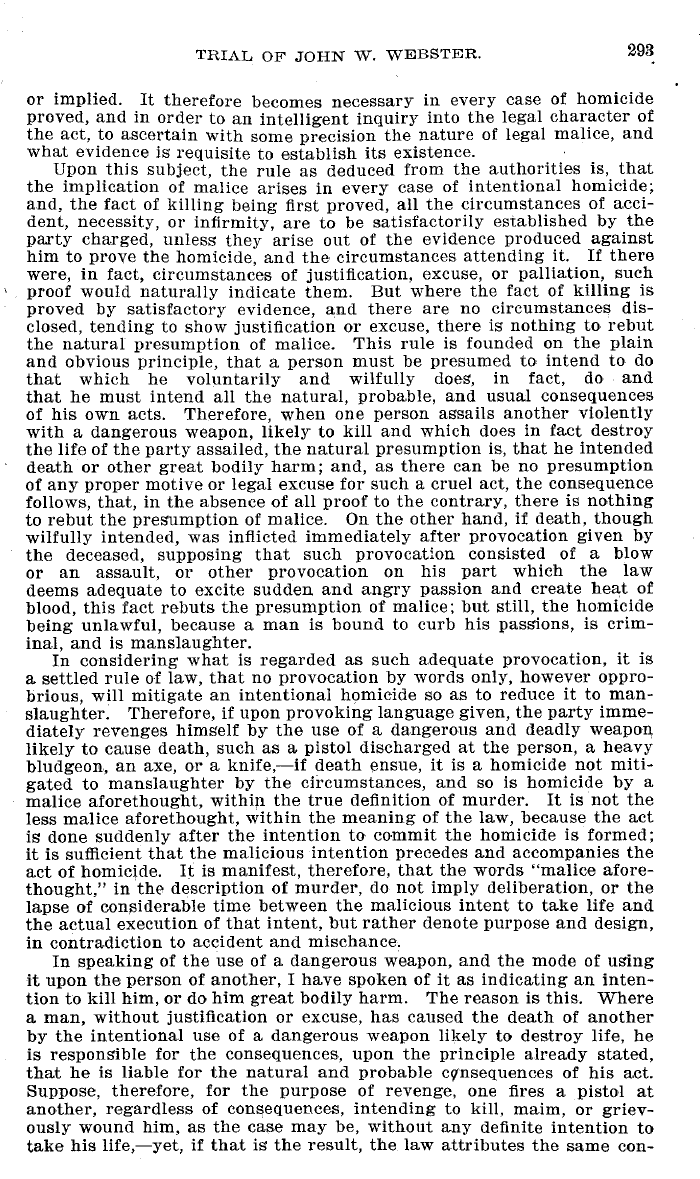|
TRIAL OF JOHN W. WEBSTER. 293
or implied. It therefore becomes necessary in every case of homicide
proved, and in order to an intelligent inquiry into the legal character of
the act, to ascertain with some precision the nature of legal malice, and
what evidence is requisite to establish its existence.
Upon this subject, the rule as deduced from the authorities is, that
the implication of malice arises in every case of intentional homicide;
and, the fact of killing being first proved, all the circumstances of acci-
dent, necessity, or infirmity, are to be satisfactorily established by the
party charged, unless they arise out of the evidence produced against
him to prove the homicide, and the circumstances attending it. If there
were, in fact, circumstances of justification, excuse, or palliation, such
proof would naturally indicate them. But where the fact of killing is
proved by satisfactory evidence, and there are no circumstances dis-
closed, tending to show justification or excuse, there is nothing to rebut
the natural presumption of malice. This rule is founded on the plain
and obvious principle, that a person must be presumed to intend to do
that which he voluntarily and wilfully does, in fact, do and
that he must intend all the natural, probable, and usual consequences
of his own acts. Therefore, when one person assails another violently
with a dangerous weapon, likely to kill and which does in fact destroy
the life of the party assailed, the natural presumption is, that he intended
death or other great bodily harm; and, as there can be no presumption
of any proper motive or legal excuse for such a cruel act, the consequence
follows, that, in the absence of all proof to the contrary, there is nothing
to rebut the presumption of malice. On the other hand, if death, though
wilfully intended, was inflicted immediately after provocation given by
the deceased, supposing that such provocation consisted of a blow
or an assault, or other provocation on his part which the law
deems adequate to excite sudden and angry passion and create heat of
blood, this fact rebuts the presumption of malice; but still, the homicide
being unlawful, because a man is bound to curb his passions, is crim-
inal, and is manslaughter.
In considering what is regarded as such adequate provocation, it is
a settled rule of law, that no provocation by words only, however oppro-
brious, will mitigate an intentional homicide so as to reduce it to man-
slaughter. Therefore, if upon provoking language given, the party imme-
diately revenges himself by the use of a dangerous and deadly weapon
likely to cause death, such as a pistol discharged at the person, a heavy
bludgeon, an axe, or a knife,-if death ensue, it is a homicide not miti-
gated to manslaughter by the circumstances, and so is homicide by a
malice aforethought, within the true definition of murder. It is not the
less malice aforethought, within the meaning of the law, because the act
is done suddenly after the intention to commit the homicide is formed;
it is sufficient that the malicious intention precedes and accompanies the
act of homicide. It is manifest, therefore, that the words "malice afore-
thought," in the description of murder, do not imply deliberation, or the
lapse of considerable time between the malicious intent to take life and
the actual execution of that intent, but rather denote purpose and design,
in contradiction to accident and mischance.
In speaking of the use of a dangerous weapon, and the mode of using
it upon the person of another, I have spoken of it as indicating an inten-
tion to kill him, or do him great bodily harm. The reason is this. Where
a man, without justification or excuse, has caused the death of another
by the intentional use of a dangerous weapon likely to destroy life, he
is responsible for the consequences, upon the principle already stated,
that he is liable for the natural and probable cqnsequences of his act.
Suppose, therefore, for the purpose of revenge, one fires a pistol at
another, regardless of consequences, intending to kill, maim, or griev-
ously wound him, as the case may be, without any definite intention to
take his life,-yet, if that is the result, the law attributes the same con-
|

